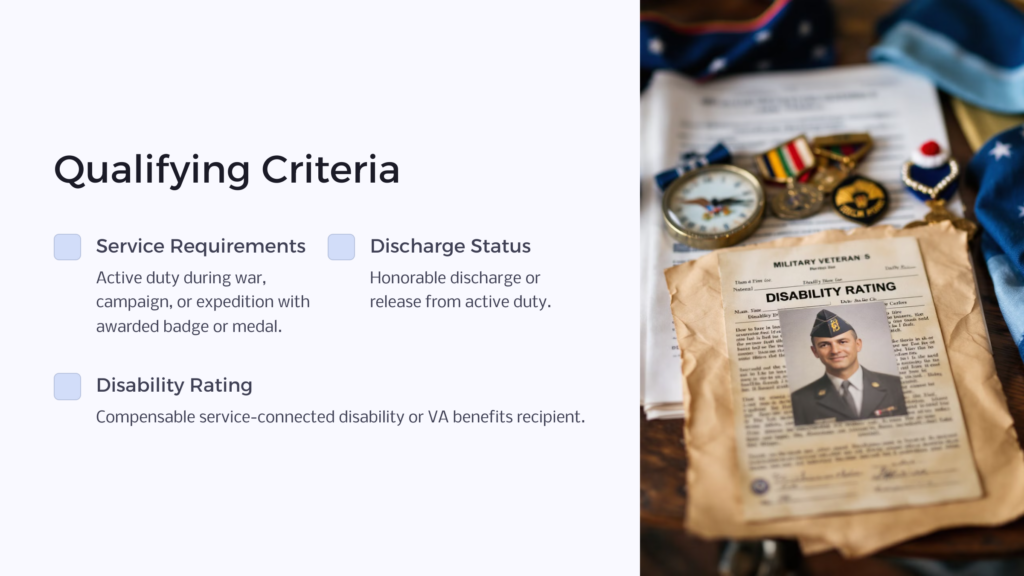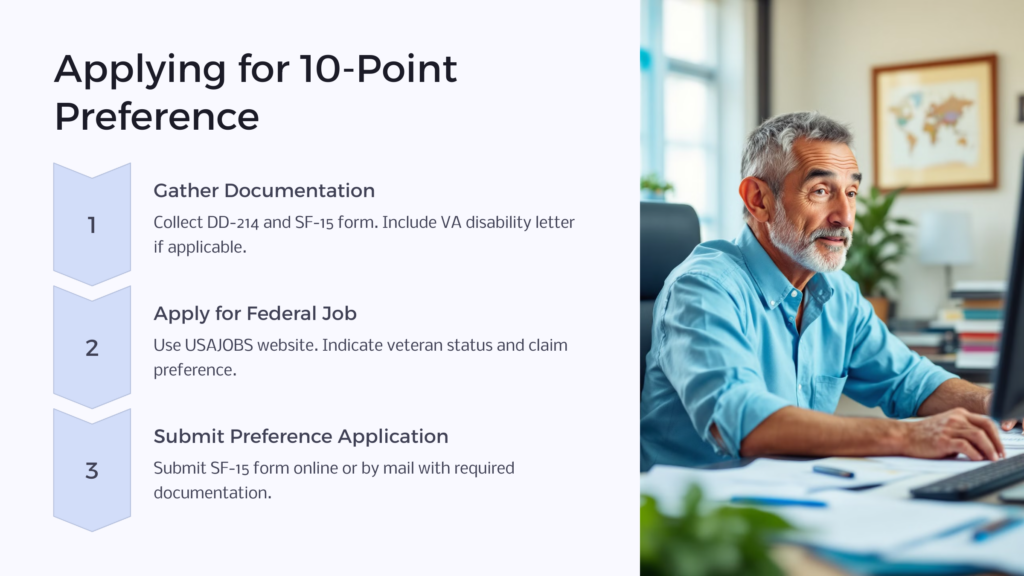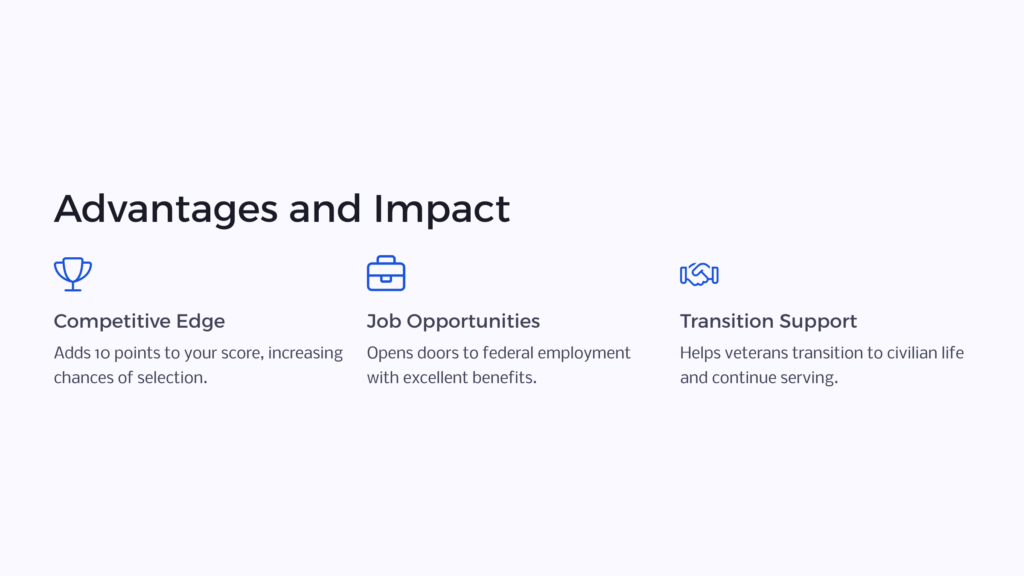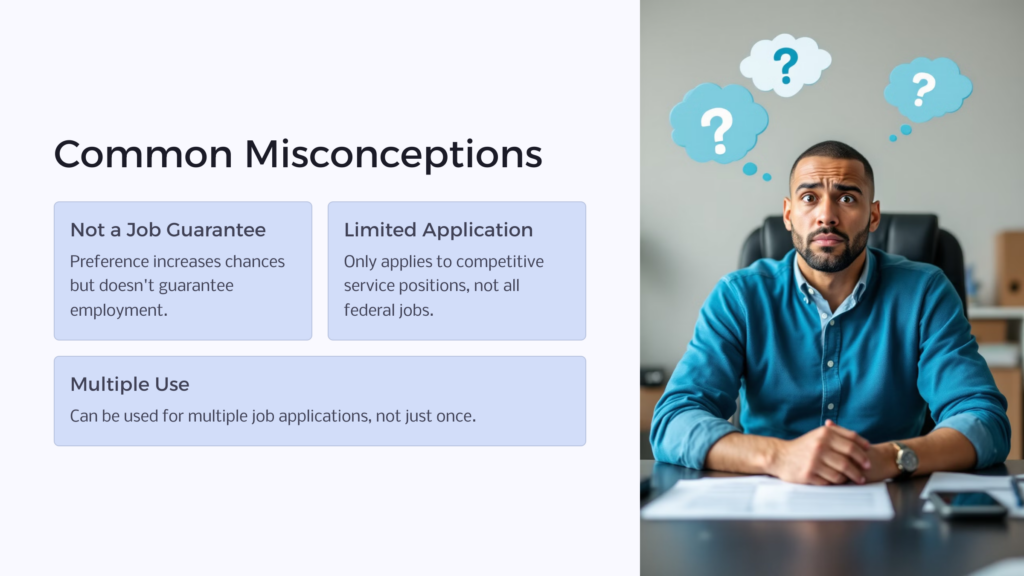If you’re a veteran who is looking for a job in the federal government, you may have heard of the 10-point veterans preference. This is a system that gives eligible veterans an advantage when applying for federal jobs. Essentially, if a qualified veteran is eligible for the 10-point preference, they will be placed ahead of other applicants in the hiring process.
So, what exactly is the 10-point veterans’ preference? It’s a system that awards additional points to veterans applying for federal jobs. These points are added to a veteran’s score on a civil service exam or application, giving them a higher ranking than non-veteran applicants. The preference can be used for both competitive and accepted service positions, and it can provide major federal employment advantages.
Origins and Purpose
If you are a veteran seeking employment in the federal government, you may be entitled to veterans preference. Veterans preference is a system that gives those eligible an advantage in the federal hiring process for veterans. The origins of veteran’s preference date back to the Civil War, when soldiers returning from the war faced significant difficulties in finding employment.
In 1864, Congress passed the first law granting veterans’ preference, which gave veterans a hiring preference for federal jobs. The law was intended to reward veterans for their service and to help them find employment after their military service. Since then, the law has been amended several times, and veteran preference has become an important part of federal hiring practices.
Veterans preference is divided into two categories: 5-point preference and 10-point preference. Veterans who served on active duty during certain periods and who were discharged under honorable conditions are entitled to a 5-point preference. Veterans who have a service-connected disability or who received a Purple Heart are entitled to a 10-point preference.
The purpose of veteran’s preference is to recognize the sacrifices that veterans have made for their country and to give them an advantage when it comes to government job opportunities for veterans. By giving veterans an advantage in hiring, the federal government can repay veterans for their service and ensure that they have access to stable, well-paying jobs. Additionally, veterans’ preference helps to ensure that the federal government has a diverse and talented workforce.
Qualifying Criteria

If you are a veteran or an eligible family member of a veteran, you may be able to receive a 10-point preference when going through the federal hiring process for veterans. To qualify for this preference, you must meet specific criteria and conditions.
Service Requirements
To qualify for 10-point preference, you must have served on active duty in the Armed Forces of the United States during a war, campaign, or expedition for which a campaign badge or service medal was awarded. This includes service during the Gulf War, Operation Enduring Freedom, and Operation Iraqi Freedom.
Discharge Status
You must have been discharged or released from active duty in the Armed Forces under honorable conditions. If you were discharged under other than honorable conditions, you may still be eligible for a 10-point preference if you have a compensable service-connected disability or if you were discharged or released from active duty because of a disability incurred or aggravated in the line of duty.
Disability Rating
You must have a compensable service-connected disability or receive compensation, VA disability benefits, or pension from the military or the Department of Veterans Affairs. If you have a present service-connected disability, you may also be eligible for a 10-point preference.
Eligibility Requirements
Spouses, widows, widowers, and parents of veterans may also be eligible for a 10-point preference if the veteran is permanently disabled, or if the veteran died as a result of a service-connected disability. Children of veterans are not eligible for a 10-point preference.
Applying for 10-Point Preference

When applying for federal employment, you must submit documentation to verify your eligibility for 10-point preference. This may include your DD-214, Certificate of Release or Discharge from Active Duty, or other acceptable documentation.
It is important to note that a 10-point preference does not guarantee an appointment to a federal position. It is simply a way to give eligible veterans and their family members an advantage in the hiring process and acts as a form of veteran employment assistance.
Advantages and Impact

Having a 10-point veterans preference can be a significant advantage when it comes to applying for federal employment opportunities. It can increase your chances of being selected for a job, especially if you meet the qualifications for the position. The preference gives you an additional 10 points on top of your regular score, which can make a big difference in a highly competitive hiring process.
The preference also allows veterans to receive additional military service points, which are added to their overall score. This means that veterans who served in the armed forces can receive extra credit for their service, making them more competitive candidates for federal jobs. Additionally, disabled veterans receive even more points, making them even more competitive.
The impact of having a 10-point veterans preference can be significant. It can open up doors to federal job opportunities that may not have been available otherwise. It can also provide a sense of security and stability, as federal jobs often come with excellent benefits, including health insurance, retirement plans, and paid time off.
Furthermore, the preference can help veterans transition back into civilian life after their military service. It provides them with a clear path to federal employment and helps them to continue serving their country in a different capacity. The preference also recognizes the sacrifices that veterans have made and gives them the recognition they deserve.
Overall, having a 10-point veterans preference can be a valuable asset for veterans seeking federal employment advantages. It can provide them with a competitive advantage, additional military service points, and excellent benefits. The preference also recognizes the sacrifices that veterans have made and gives them the recognition they deserve.
Application Process
If you are a veteran seeking a federal job, you may be eligible for a 10-point preference. This preference can give you an advantage during the hiring process. Here is a step-by-step guide on how to apply for this preference.
Step 1: Gather Required Documentation
Before you apply for the 10-point preference, you must gather the required documentation. This includes your Certificate of Release or Discharge from Active Duty (DD-214) and the 10-Point Veteran Preference (SF-15) application form. If you have a disability rating from the VA, you may also need to provide a letter from the VA Regional Office stating your percentage of disability.
Step 2: Apply for a Federal Job
Once you have your documentation, you can start applying for federal jobs. You can find government job opportunities for veterans on the USAJOBS website. When you apply for a job, make sure to indicate that you are a veteran and that you are claiming the 10-point preference.
Step 3: Submit Your Application for the 10-Point Preference
After you apply for a federal job, you will need to submit your Application for 10-Point Veteran Preference (SF-15). You can submit this form online through the USAJOBS website or by mail to the agency where you applied for the job. If you are submitting the form by mail, make sure to include a copy of your DD-214 and any other required documentation.
Common Misconceptions

As a veteran, you are entitled to a 10-point preference when going through the federal hiring process for veterans. However, there are many misconceptions about this preference that can lead to confusion or missed opportunities. In this section, we will address and debunk some of the most common myths surrounding the 10-point veterans preference.
Myth: You automatically get the job if you have a 10-point preference
This is not true. While having a 10-point preference can give you an advantage in the hiring process, it does not guarantee that you will get the job. You still need to meet the qualifications for the position and compete with other applicants. However, having the preference can increase your chances of being selected for an interview or being hired.
Myth: The 10-point preference applies to all federal jobs
This is also false. The 10-point preference only applies to competitive service positions, which are jobs that are filled through a competitive hiring process. Some federal jobs, such as those in the excepted service or Senior Executive Service, are not subject to competitive hiring and therefore do not offer the preference.
Myth: You can only use the preference once
This is not accurate. You can use the 10-point preference for any eligible federal job application. However, you can only use it once per job announcement. If you apply for multiple positions under the same announcement, you can only claim the preference for one of them.
Myth: You can only claim the preference if you have a service-connected disability
While having a service-connected disability can give you a 10-point preference, it is not the only way to qualify. You can also claim the preference if you are a Purple Heart recipient, a spouse or widow(er) of a disabled veteran, or the mother of a deceased veteran. Additionally, if you served during certain periods of war or national emergency, you may be eligible for the preference even without a disability.
Remember that for preference eligibility in the United States, you must be a veteran who served on active duty in the Armed Forces and was discharged or released under honorable conditions. You must also have a compensable service-connected disability, be receiving compensation, disability retirement benefits, or pension from the military or the Department of Veterans Affairs, or be the spouse or mother of a disabled veteran.
When you apply for a federal job, make sure to indicate that you are preference-eligible and provide the required documentation, such as your DD-214 and VA disability letter.
It’s important to note that while the 10-point preference can give you an advantage in the hiring process, your preference eligibility does not guarantee that you will be selected for the job. You still need to meet the qualifications and requirements for the position and compete with other applicants.
If you’re looking for more information when it comes to your military service benefits and the 10-point veterans’ preference, visit Benefits.com.
 Benefits.com Advisors
Benefits.com Advisors
With expertise spanning local, state, and federal benefit programs, our team is dedicated to guiding individuals towards the perfect program tailored to their unique circumstances.
Rise to the top with Peak Benefits!
Join our Peak Benefits Newsletter for the latest news, resources, and offers on all things government benefits.



















